Opinion & Analysis
Why these 10 PGA Tour stars are underperforming in 2016
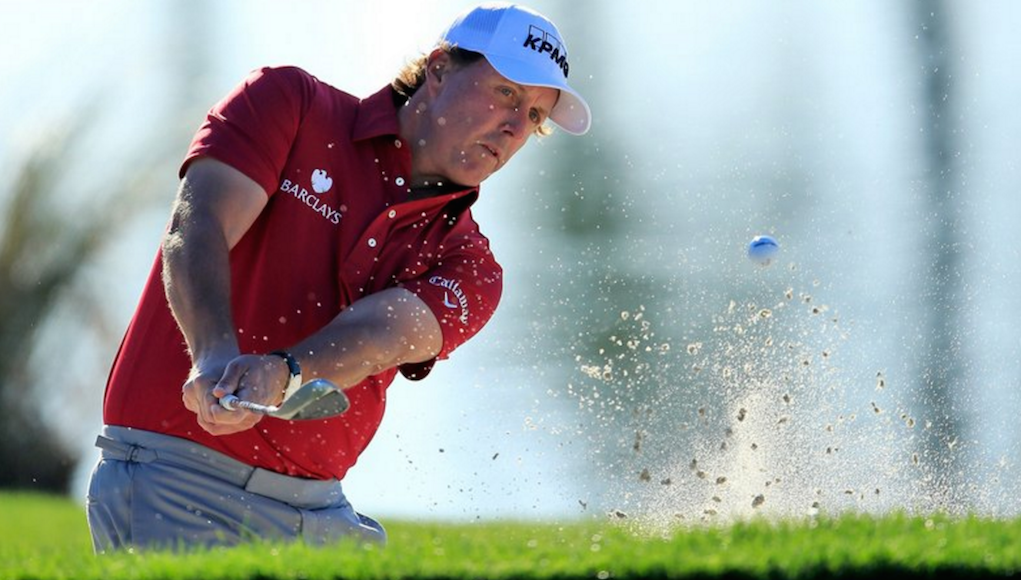
As we approach the U.S. Open and Summer Olympics — where golf will be part of the competition — along with the Ryder Cup this fall, I decided to look at what was going on with some of the more popular players on Tour who are not quite meeting fan expectations. The following rankings are based out of 196 players.
Jordan Spieth
Spieth has one victory on the PGA Tour this season, and is currently sixth on the Money List. However, his collapse at the Masters, missed cut at The Players Championship and struggle on Sunday at the Byron Nelson has caused some concern from the fans. His driving is generally excellent, but his iron play has dropped off dramatically. He was once one of the top-5 iron players on Tour, and now he’s only a little better than average.
Spieth currently ranks 86th on shots from the fairway/tee box from 75-225 yards, where he was ranked 12th in that category last season.
Justin Rose
Rose has recorded eight top-25 finishes in 11 starts, and ranks seventh in adjusted scoring average. He’s having a fine season, but he has not recorded a victory. The biggest issue for him is his putting. From a scoring perspective, he has been unable to make a lot of birdies on the par-4’s (102nd), which is a result of his below-average putting. His Green Zone performance is a little off, but that is not a major culprit, and he has typically been an excellent Green Zone performer. I expect that to improve as time goes along.
If Rose can start making some putts, the numbers project favorably toward him contending in the next three majors.
Henrik Stenson
Stenson recorded a third-place finish at Bay Hill and a second-place finish at Houston. After that, he finished 24th at the Masters and then missed his past two cuts. Overall, his ball striking has been great, but his short game and putting have hamstrung him.
He has been particularly awful on short game shots from 10-20 yards (191st), which is the most critical area for short game play. His putting from 3-5 feet has been excellent (4th), but he has struggled from outside of that range. He ranks 36th on Birdie Putts from 5-15 feet, while ranking 182nd on par-or-worse putts from 5-15 feet. That is typically a sign of a player that is hitting their putts too firmly. While his ball striking is top notch, at this point, he is not giving himself much of a chance if he misses a green in regulation because his short game and putting are killing him.
Gary Woodland
Woodland is a bit of a unique case, as he ranks 23rd in adjusted scoring average while ranking 89th in earnings. Typically, those rankings tend to match each other, especially for a player like Woodland who gets to play in large purse events.
What we have seen from Woodland is that he has only missed one cut in 16 events. That means he should have a low total adjusted scoring average, however, he has yet to record a top-10 finish. His best finish was a T13th at the Sony Open, and he has six top-25 finishes in total. So he has been good enough to finish right around 25th in an event, but not able to finish much higher than that.
Here’s a look at Woodland’s Scoring Average rankings by round:
While most people would think Round 4 scoring average is more important, it’s actually the performance in Rounds 1 and 2 that matter much more in terms of Tour success. Furthermore, Round 4 scoring average typically falls in line with the player’s scoring average in Rounds 1-3 over time.
Woodland has also typically been a great Red Zone performer as well. So while he has not had the big finishes at this current time, the numbers project that he is likely to have some great finishes as we go into the summer. His Red Zone Play is likely to improve, and his performance in Round 4 should start to match his performances in Rounds 1-3.
Phil Mickelson
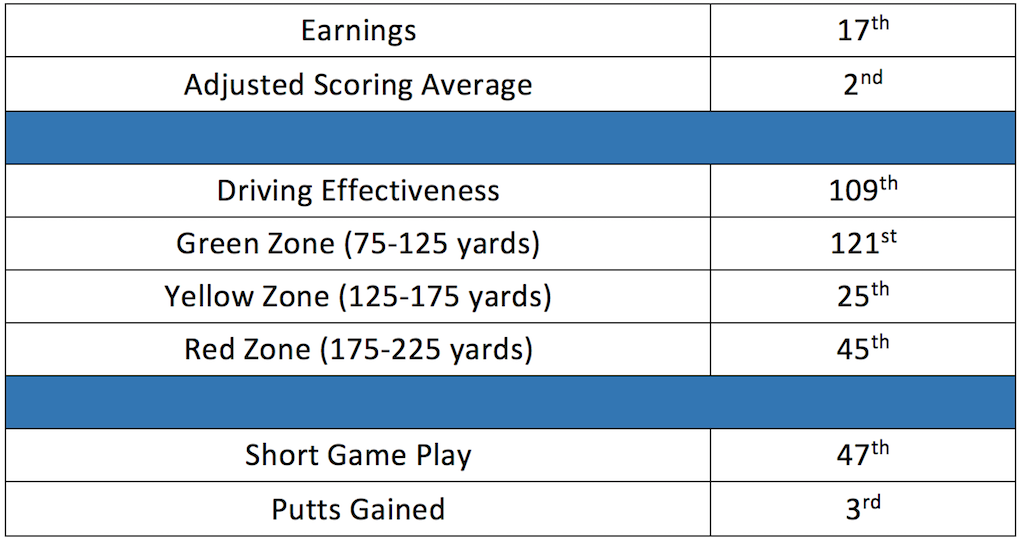 Mickelson has had a great season, but the standards for him are so high that he’s expected to have won by now, and to minimize missed cuts. He has missed three of his past four cuts with no victories, but has four top-10 finishes.
Mickelson has had a great season, but the standards for him are so high that he’s expected to have won by now, and to minimize missed cuts. He has missed three of his past four cuts with no victories, but has four top-10 finishes.
His performance metrics have been excellent, but he has struggled to put each piece of the game together at the same time. Earlier in the year, he was driving the ball very well, but his iron play and putting were only above average. His short game play was a little below average. In the last few events, his iron play, short game and putting have been very good, but his driving has regressed. In his last event (The Players Championship), he finished last in driving effectiveness.
This is fairly common for players who are starting to rejuvenate their game like Phil has, however; they struggle to get all of the important pieces of the game to work at the same time. Therefore, the numbers point to Phil having great success and meeting fan expectations, soon.
Keegan Bradley
What stands out for Bradley is his struggles moving to the non-anchored putter. While that is certainly a major issue, a player of his length, driving skill and overall ballstriking skill should be performing much better on the Par-5s. Simply put, he can play a Par-5 more like a Par-4 compared to the average player in an event. And even with awful putting, that should translate to ranking far better than 158th in Par-5 Scoring Average.
I have him ranked 157th in Par-5 Aggressiveness. Par-5 Aggressiveness is an algorithm that determines how often the player should be going for par-5s in two shots based on the “Par-5 Go For It” percentages of each par-5 they have played, their distance off the tee, hit fairway percentage, performance from 225-275 yards and short game performance. For Bradley, his projected optimal Par-5 Go For It Percentage is at 68 percent and he has gone for par-5s in two shots only 58.9 percent of the time.
The good news is that this is the best Bradley has ever struck the ball with his irons in his career. Typically, he has been a very good Red Zone player (175-225 yards), but has struggled from the Green Zone (75-125 yards) and the Yellow Zone (125-175 yards). If he can straighten out his putting and get near the average on Tour in Putts Gained, he would be projected to get into contention immediately. But, he may be missing out on those victories if he does not become more aggressive on the Par-5s.
Hunter Mahan
The numbers have projected Mahan’s regression for quite some time. He simply has struggled too much from the Red Zone (175-225 yards) for too long to continue to be successful on Tour. Eventually, his driving started to regress, as well as his Yellow Zone play (125-175 yards).
Good Red-Zone performers tend to do a good job at avoiding bogeys and those big numbers that kill a round of golf. Good Yellow-Zone performers tend to make more birdies on the Par-4s, because they are hitting those approach shots closer to the makeable putt range. For a while, Mahan was countering his poor Red-Zone play with great Yellow Zone play. He no longer does that, hence his struggles this season.
It’s funny because most people tend to think that Mahan was never quite an upper echelon player (top-5 in the world) because of his putting and short game. That’s never been the case, though. He has struggled severely with his Red Zone Play, and now his Yellow Zone play and driving are following suit.
Ian Poulter
Poulter’s metrics may boost the hopes of U.S. Ryder Cup fans, as he has been a ferocious competitor for the European Ryder Cup team… but I wouldn’t count the chickens before they hatch. He is still a great short-game performer, which is the one area that has produced the best Ryder Cup players over the years. He is also a strong performer from the Red Zone, which is another key area in the Ryder Cup, and his putting is better than average.
Obviously, Poulter’s Yellow- and Green-Zone play has regressed. He typically has been a good Yellow-Zone performer and an inconsistent Green-Zone performer. Therefore, I would not be surprised if he regains his Yellow Zone performance as the season goes along.
His driving has also played a role in his regression. His club speed has slowed down considerably, as he was at 111.95 mph in 2014 and is now at 109.67 mph. A drop in club speed of 2.3 mph is sizable by Tour standards. He also ranks 190th in Hit Fairway Bunker percentage. That helps explain his regression from the Yellow Zone, as he is getting a lot of those shots from the fairway bunkers.
Webb Simpson
Simpson’s ranking in earnings is much lower than his adjusted-scoring-average ranking, due to the fact that he has only played in 10 events this season. And fans of Simpson should be more concerned with his adjusted scoring average than his earnings. Adjusted scoring average will serve as a better predictor for a player’s earnings and FedEx points at the end of the season.
The good news for Simpson is that he is striking the ball quite well, and his Short Game is sharp. However, like Keegan Bradley, he has struggled with the adjustment to the non-anchored putter. Some may say that it gives credence to the ban on anchored putters, but as far as belly putters go, we simply did not have enough data to determine its true effect on putting performance. And one could argue that after a rough season putting in 2015 (where he still used anchor putting in some events), Adam Scott has putted well this season, as he is currently 71st in Putts Gained.
Boo Weekley
I think most fans of Boo would expect these type of metrics: great ball striking, poor short-game play and poor putting.
This season, Boo has had struggles from the Yellow Zone. He has never been a consistently great performer from 125-150 yards, but he has had some inexplicable struggles from 150-175 yards (175th). This has greatly hurt his ability to make birdies on the Par-4’s (158th) and has hurt his Par-3 Scoring Average (151st).
We are also seeing Boo’s club speed drop substantially. He is currently at 111.6 mph, and was at 113.4 mph last season. He was at 114.9 mph in 2012.
- LIKE83
- LEGIT11
- WOW15
- LOL4
- IDHT2
- FLOP5
- OB2
- SHANK10
19th Hole
Vincenzi’s 2024 Zurich Classic of New Orleans betting preview

The PGA TOUR heads to New Orleans to play the 2023 Zurich Classic of New Orleans. In a welcome change from the usual stroke play, the Zurich Classic is a team event. On Thursday and Saturday, the teams play best ball, and on Friday and Sunday the teams play alternate shot.
TPC Louisiana is a par 72 that measures 7,425 yards. The course features some short par 4s and plenty of water and bunkers, which makes for a lot of exciting risk/reward scenarios for competitors. Pete Dye designed the course in 2004 specifically for the Zurich Classic, although the event didn’t make its debut until 2007 because of Hurricane Katrina.
Coming off of the Masters and a signature event in consecutive weeks, the field this week is a step down, and understandably so. Many of the world’s top players will be using this time to rest after a busy stretch.
However, there are some interesting teams this season with some stars making surprise appearances in the team event. Some notable teams include Patrick Cantlay and Xander Schauffele, Rory McIlroy and Shane Lowry, Collin Morikawa and Kurt Kitayama, Will Zalatoris and Sahith Theegala as well as a few Canadian teams, Nick Taylor and Adam Hadwin and Taylor Pendrith and Corey Conners.
Past Winners at TPC Louisiana
- 2023: Riley/Hardy (-30)
- 2022: Cantlay/Schauffele (-29)
- 2021: Leishman/Smith (-20)
- 2019: Palmer/Rahm (-26)
- 2018: Horschel/Piercy (-22)
- 2017: Blixt/Smith (-27)
2024 Zurich Classic of New Orleans Picks
Tom Hoge/Maverick McNealy +2500 (DraftKings)
Tom Hoge is coming off of a solid T18 finish at the RBC Heritage and finished T13 at last year’s Zurich Classic alongside Harris English.
This season, Hoge is having one of his best years on Tour in terms of Strokes Gained: Approach. In his last 24 rounds, the only player to top him on the category is Scottie Scheffler. Hoge has been solid on Pete Dye designs, ranking 28th in the field over his past 36 rounds.
McNealy is also having a solid season. He’s finished T6 at the Waste Management Phoenix Open and T9 at the PLAYERS Championship. He recently started working with world renowned swing coach, Butch Harmon, and its seemingly paid dividends in 2024.
Keith Mitchell/Joel Dahmen +4000 (DraftKings)
Keith Mitchell is having a fantastic season, finishing in the top-20 of five of his past seven starts on Tour. Most recently, Mitchell finished T14 at the Valero Texas Open and gained a whopping 6.0 strokes off the tee. He finished 6th at last year’s Zurich Classic.
Joel Dahmen is having a resurgent year and has been dialed in with his irons. He also has a T11 finish at the PLAYERS Championship at TPC Sawgrass which is another Pete Dye track. With Mitchell’s length and Dahmen’s ability to put it close with his short irons, the Mitchell/Dahmen combination will be dangerous this week.
Taylor Moore/Matt NeSmith +6500 (DraftKings)
Taylor Moore has quickly developed into one of the more consistent players on Tour. He’s finished in the top-20 in three of his past four starts, including a very impressive showing at The Masters, finishing T20. He’s also finished T4 at this event in consecutive seasons alongside Matt NeSmith.
NeSmith isn’t having a great 2024, but has seemed to elevate his game in this format. He finished T26 at Pete Dye’s TPC Sawgrass, which gives the 30-year-old something to build off of. NeSmith is also a great putter on Bermudagrass, which could help elevate Moore’s ball striking prowess.
- LIKE2
- LEGIT1
- WOW0
- LOL0
- IDHT0
- FLOP1
- OB0
- SHANK0
19th Hole
Vincenzi’s 2024 LIV Adelaide betting preview: Cam Smith ready for big week down under

After having four of the top twelve players on the leaderboard at The Masters, LIV Golf is set for their fifth event of the season: LIV Adelaide.
For both LIV fans and golf fans in Australia, LIV Adelaide is one of the most anticipated events of the year. With 35,000 people expected to attend each day of the tournament, the Grange Golf Club will be crawling with fans who are passionate about the sport of golf. The 12th hole, better known as “the watering hole”, is sure to have the rowdiest of the fans cheering after a long day of drinking some Leishman Lager.
The Grange Golf Club is a par-72 that measures 6,946 yards. The course features minimal resistance, as golfers went extremely low last season. In 2023, Talor Gooch shot consecutive rounds of 62 on Thursday and Friday, giving himself a gigantic cushion heading into championship Sunday. Things got tight for a while, but in the end, the Oklahoma State product was able to hold off The Crushers’ Anirban Lahiri for a three-shot victory.
The Four Aces won the team competition with the Range Goats finishing second.
*All Images Courtesy of LIV Golf*
Past Winners at LIV Adelaide
- 2023: Talor Gooch (-19)
Stat Leaders Through LIV Miami
Green in Regulation
- Richard Bland
- Jon Rahm
- Paul Casey
Fairways Hit
- Abraham Ancer
- Graeme McDowell
- Henrik Stenson
Driving Distance
- Bryson DeChambeau
- Joaquin Niemann
- Dean Burmester
Putting
- Cameron Smith
- Louis Oosthuizen
- Matt Jones
2024 LIV Adelaide Picks
Cameron Smith +1400 (DraftKings)
When I pulled up the odds for LIV Adelaide, I was more than a little surprised to see multiple golfers listed ahead of Cameron Smith on the betting board. A few starts ago, Cam finished runner-up at LIV Hong Kong, which is a golf course that absolutely suits his eye. Augusta National in another course that Smith could roll out of bed and finish in the top-ten at, and he did so two weeks ago at The Masters, finishing T6.
At Augusta, he gained strokes on the field on approach, off the tee (slightly), and of course, around the green and putting. Smith able to get in the mix at a major championship despite coming into the week feeling under the weather tells me that his game is once again rounding into form.
The Grange Golf Club is another course that undoubtedly suits the Australian. Smith is obviously incredibly comfortable playing in front of the Aussie faithful and has won three Australian PGA Championship’s. The course is very short and will allow Smith to play conservative off the tee, mitigating his most glaring weakness. With birdies available all over the golf course, there’s a chance the event turns into a putting contest, and there’s no one on the planet I’d rather have in one of those than Cam Smith.

Louis Oosthuizen +2200 (DraftKings)
Louis Oosthuizen has simply been one of the best players on LIV in the 2024 seas0n. The South African has finished in the top-10 on the LIV leaderboard in three of his five starts, with his best coming in Jeddah, where he finished T2. Perhaps more impressively, Oosthuizen finished T7 at LIV Miami, which took place at Doral’s “Blue Monster”, an absolutely massive golf course. Given that Louis is on the shorter side in terms of distance off the tee, his ability to play well in Miami shows how dialed he is with the irons this season.
In addition to the LIV finishes, Oosthuizen won back-to-back starts on the DP World Tour in December at the Alfred Dunhill Championship and the Mauritus Open. He also finished runner-up at the end of February in the International Series Oman. The 41-year-old has been one of the most consistent performers of 2024, regardless of tour.
For the season, Louis ranks 4th on LIV in birdies made, T9 in fairways hit and first in putting. He ranks 32nd in driving distance, but that won’t be an issue at this short course. Last season, he finished T11 at the event, but was in decent position going into the final round but fell back after shooting 70 while the rest of the field went low. This season, Oosthuizen comes into the event in peak form, and the course should be a perfect fit for his smooth swing and hot putter this week.

- LIKE4
- LEGIT1
- WOW0
- LOL0
- IDHT0
- FLOP0
- OB0
- SHANK0
Opinion & Analysis
The Wedge Guy: What really makes a wedge work? Part 1

Of all the clubs in our bags, wedges are almost always the simplest in construction and, therefore, the easiest to analyze what might make one work differently from another if you know what to look for.
Wedges are a lot less mysterious than drivers, of course, as the major brands are working with a lot of “pixie dust” inside these modern marvels. That’s carrying over more to irons now, with so many new models featuring internal multi-material technologies, and almost all of them having a “badge” or insert in the back to allow more complex graphics while hiding the actual distribution of mass.
But when it comes to wedges, most on the market today are still single pieces of molded steel, either cast or forged into that shape. So, if you look closely at where the mass is distributed, it’s pretty clear how that wedge is going to perform.
To start, because of their wider soles, the majority of the mass of almost any wedge is along the bottom third of the clubhead. So, the best wedge shots are always those hit between the 2nd and 5th grooves so that more mass is directly behind that impact. Elite tour professionals practice incessantly to learn to do that consistently, wearing out a spot about the size of a penny right there. If impact moves higher than that, the face is dramatically thinner, so smash factor is compromised significantly, which reduces the overall distance the ball will fly.
Every one of us, tour players included, knows that maddening shot that we feel a bit high on the face and it doesn’t go anywhere, it’s not your fault.
If your wedges show a wear pattern the size of a silver dollar, and centered above the 3rd or 4th groove, you are not getting anywhere near the same performance from shot to shot. Robot testing proves impact even two to three grooves higher in the face can cause distance loss of up to 35 to 55 feet with modern ‘tour design’ wedges.
In addition, as impact moves above the center of mass, the golf club principle of gear effect causes the ball to fly higher with less spin. Think of modern drivers for a minute. The “holy grail” of driving is high launch and low spin, and the driver engineers are pulling out all stops to get the mass as low in the clubhead as possible to optimize this combination.
Where is all the mass in your wedges? Low. So, disregarding the higher lofts, wedges “want” to launch the ball high with low spin – exactly the opposite of what good wedge play requires penetrating ball flight with high spin.
While almost all major brand wedges have begun putting a tiny bit more thickness in the top portion of the clubhead, conventional and modern ‘tour design’ wedges perform pretty much like they always have. Elite players learn to hit those crisp, spinny penetrating wedge shots by spending lots of practice time learning to consistently make contact low in the face.
So, what about grooves and face texture?
Grooves on any club can only do so much, and no one has any material advantage here. The USGA tightly defines what we manufacturers can do with grooves and face texture, and modern manufacturing techniques allow all of us to push those limits ever closer. And we all do. End of story.
Then there’s the topic of bounce and grinds, the most complex and confusing part of the wedge formula. Many top brands offer a complex array of sole configurations, all of them admittedly specialized to a particular kind of lie or turf conditions, and/or a particular divot pattern.
But if you don’t play the same turf all the time, and make the same size divot on every swing, how would you ever figure this out?
The only way is to take any wedge you are considering and play it a few rounds, hitting all the shots you face and observing the results. There’s simply no other way.
So, hopefully this will inspire a lively conversation in our comments section, and I’ll chime in to answer any questions you might have.
And next week, I’ll dive into the rest of the wedge formula. Yes, shafts, grips and specifications are essential, too.
- LIKE29
- LEGIT7
- WOW1
- LOL1
- IDHT2
- FLOP3
- OB1
- SHANK2
-

 19th Hole2 weeks ago
19th Hole2 weeks agoDave Portnoy places monstrous outright bet for the 2024 Masters
-

 19th Hole2 weeks ago
19th Hole2 weeks agoTiger Woods arrives at 2024 Masters equipped with a putter that may surprise you
-

 19th Hole3 weeks ago
19th Hole3 weeks agoReport: Tiger Woods has ‘eliminated sex’ in preparation for the 2024 Masters
-

 19th Hole1 week ago
19th Hole1 week agoTwo star names reportedly blanked Jon Rahm all week at the Masters
-

 19th Hole6 days ago
19th Hole6 days agoReport: LIV Golf identifies latest star name they hope to sign to breakaway tour
-

 19th Hole1 week ago
19th Hole1 week agoNeal Shipley presser ends in awkward fashion after reporter claims Tiger handed him note on 8th fairway
-

 19th Hole5 days ago
19th Hole5 days agoBrandel Chamblee has ‘no doubt’ who started the McIlroy/LIV rumor and why
-

 19th Hole3 weeks ago
19th Hole3 weeks agoAddiction, spinal fusion, and scam artists – Everything Anthony Kim revealed in candid interview with David Feherty

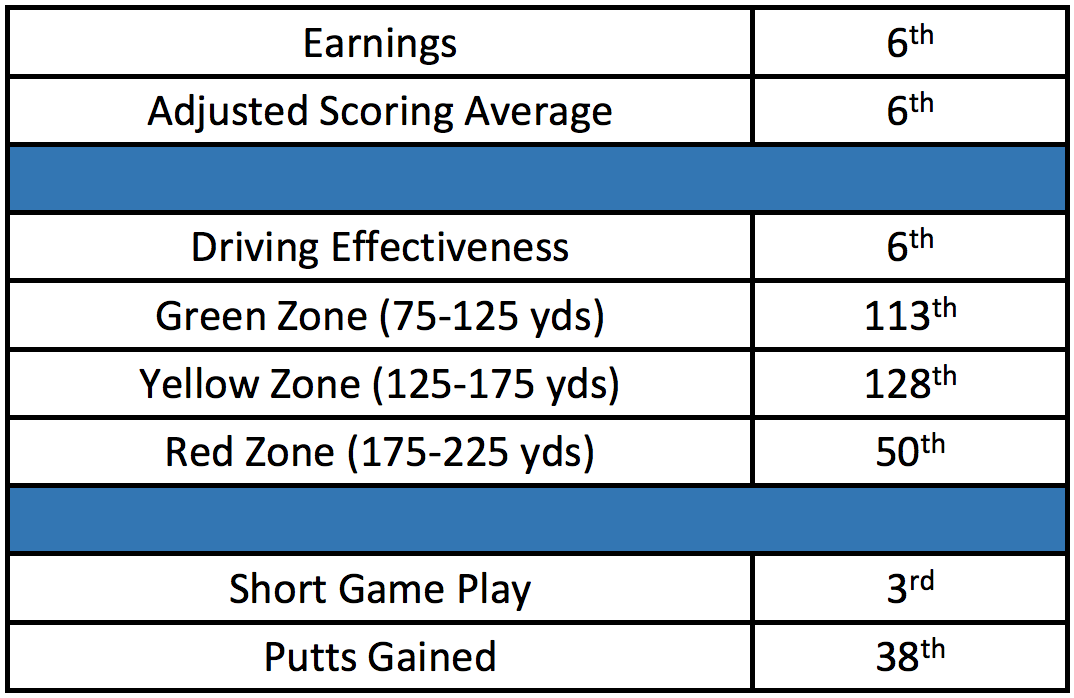
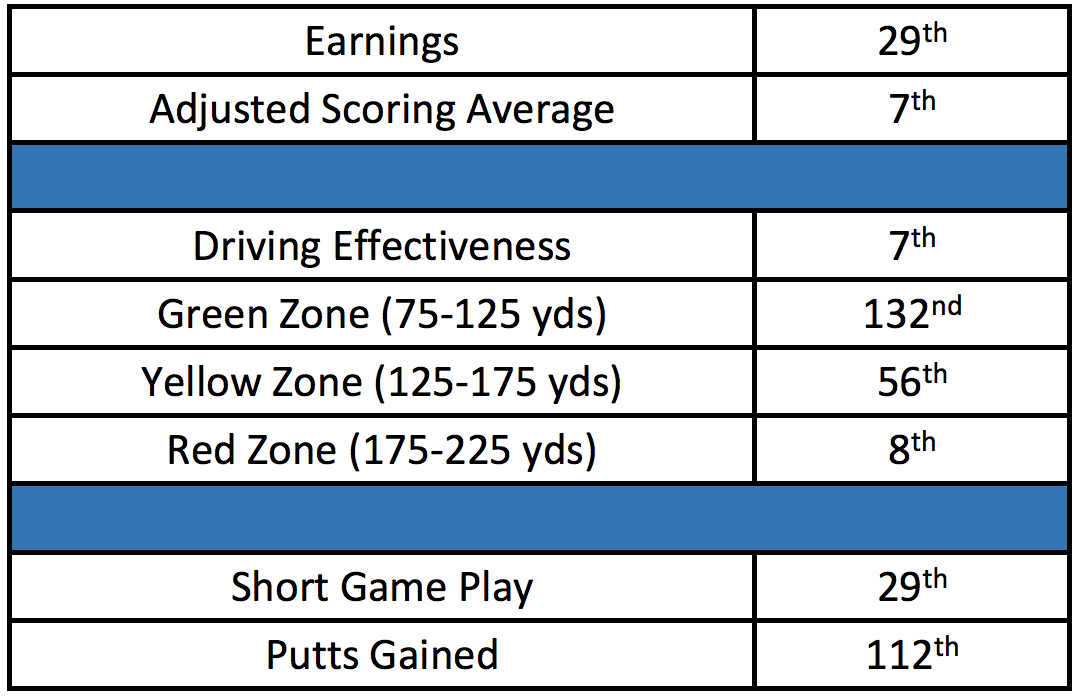
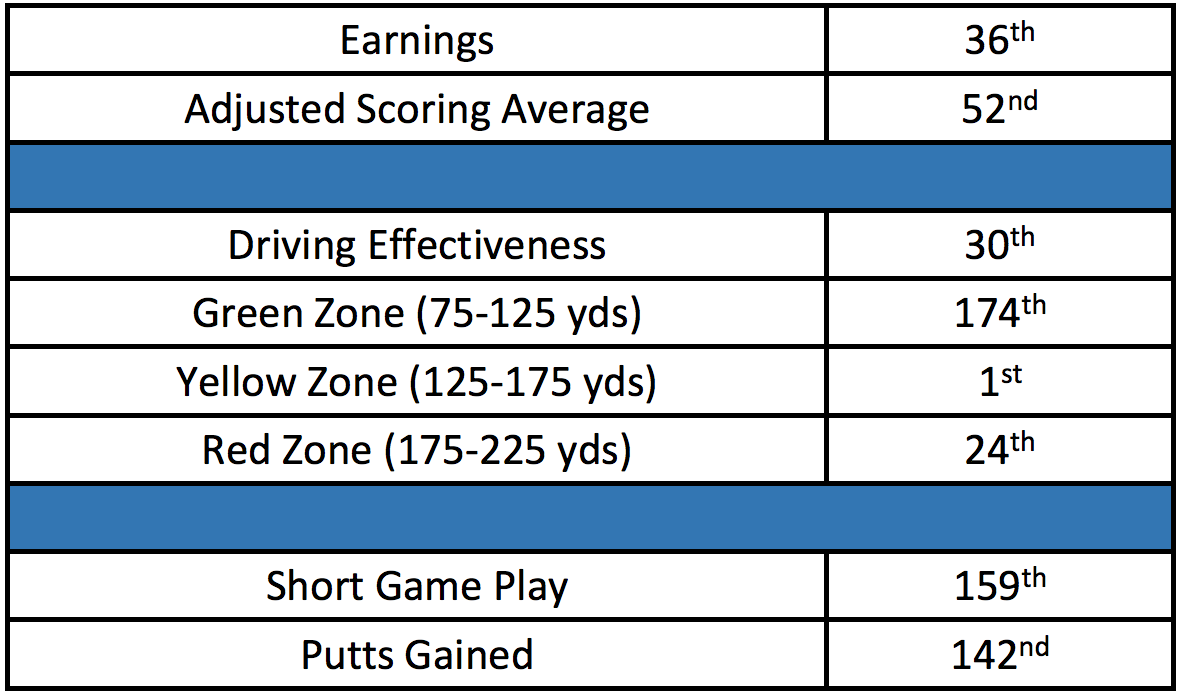
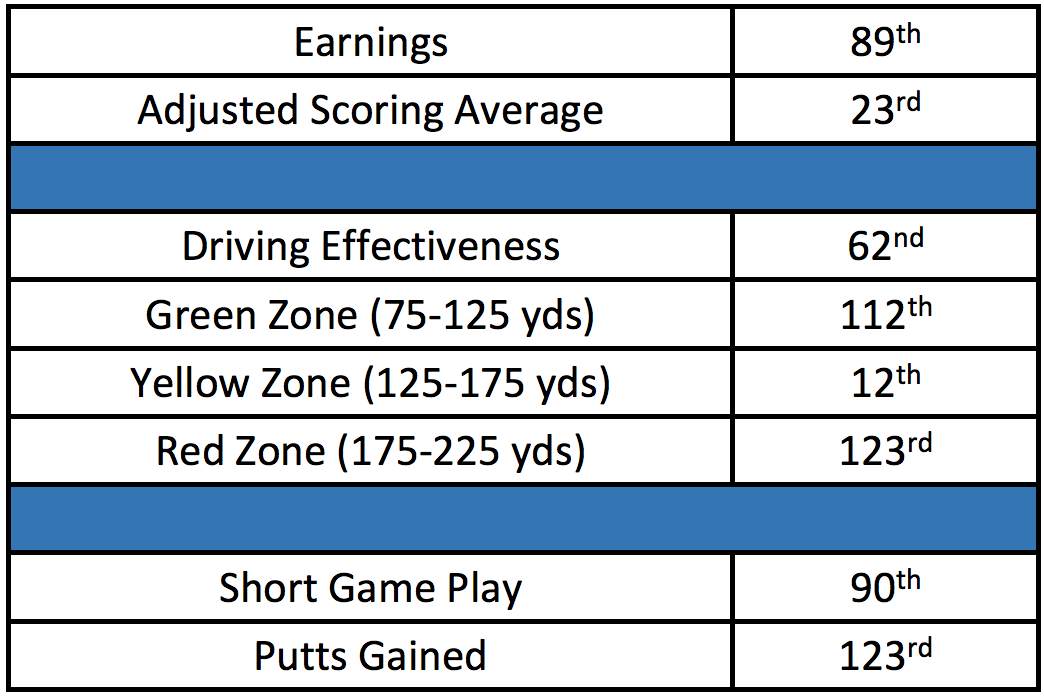

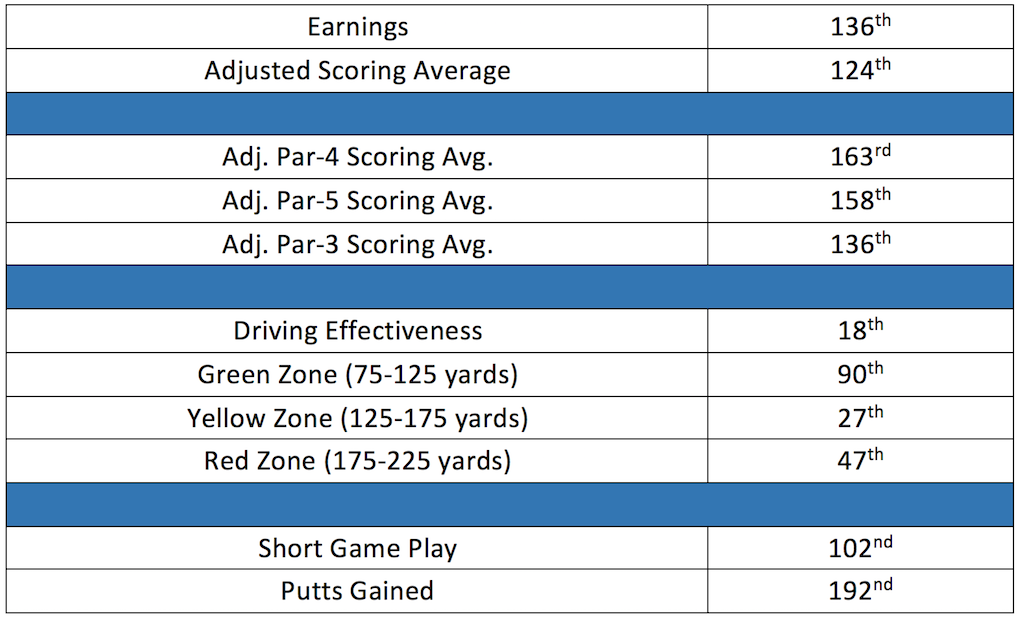
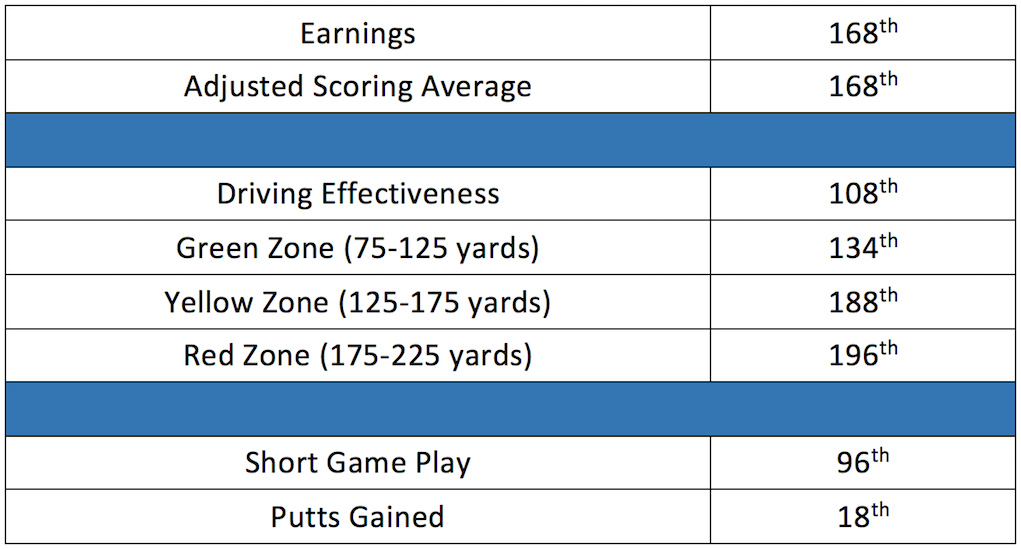
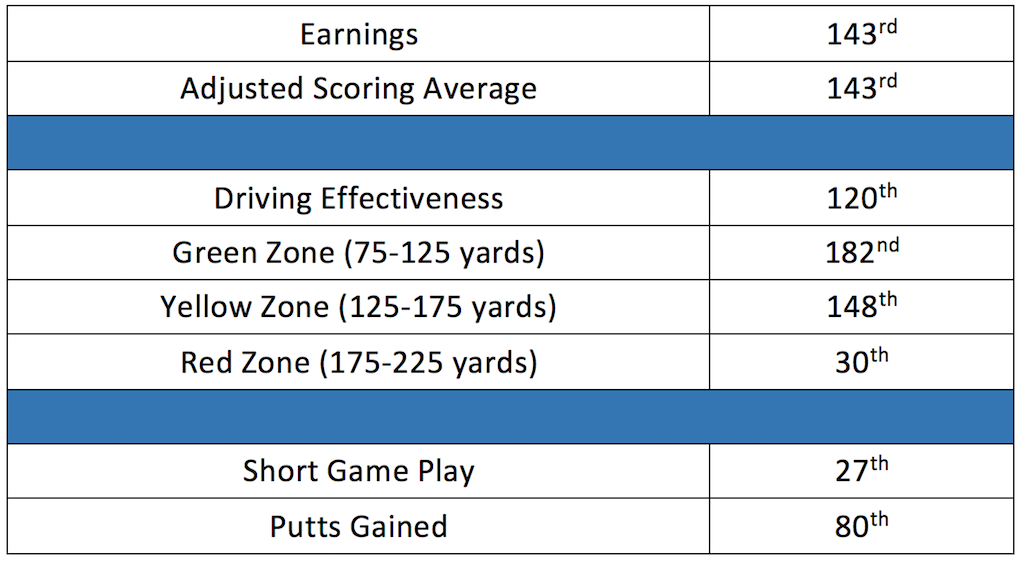
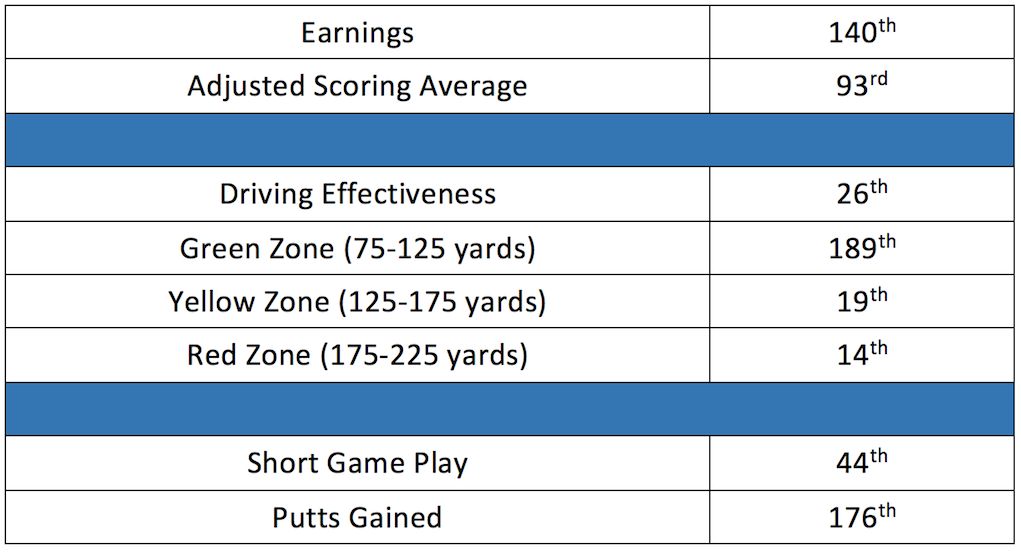
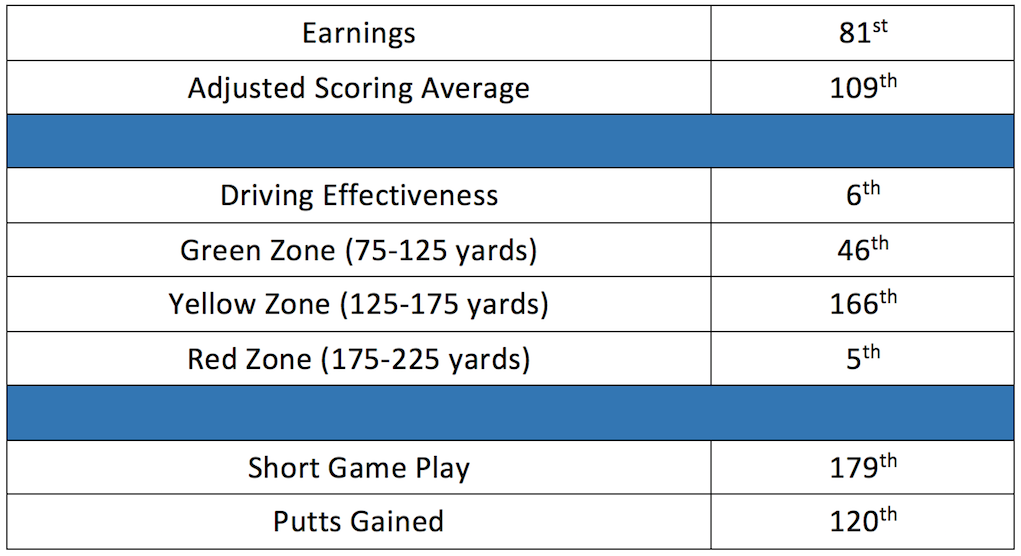














Ronald Montesano
May 30, 2016 at 11:40 am
Was going to say “Family” metric is missing for Hunter Mahan. Has so much money, wife and child and says, why struggle? why majors? why not worry? give him five years of crap play, a new swing coach or two, and he’ll wake up one morning and ask who he once might have was been, then get to work.
Nick
May 28, 2016 at 6:52 pm
“I’m not a big believer in stats.” Jezus.
BIG STU
May 28, 2016 at 4:42 am
Good article there Rich very informative I do not get into stats that much but that was good reading
Dave
May 27, 2016 at 8:24 pm
Who cares stats stats that’s all they are new breed out there ,these boys are done and if Jordan doesn’t get back to having fun and just hit it already …..well
Jochen
May 27, 2016 at 4:53 pm
Is there any good article on the website defining all the terms – green zone, adjusted scoring average, driving effectiveness etc.?
steve
May 27, 2016 at 7:36 am
Bradley, Poulter, Mahan and Simpson who expected anything from them? These guys stink. Mickelson on the other hand is 2nd in scoring, no matter how you try to spin it. Phil just needs to put 4 good rounds together
Milo
May 26, 2016 at 3:14 pm
I’d say that Mickelson this year has been better than the last 5 years.
Milo
May 27, 2016 at 11:52 pm
Jordan Spieth definitely is gonna have a nice long career. Bryson Dechambeau for me is still undetermined but I’m rooting for him.